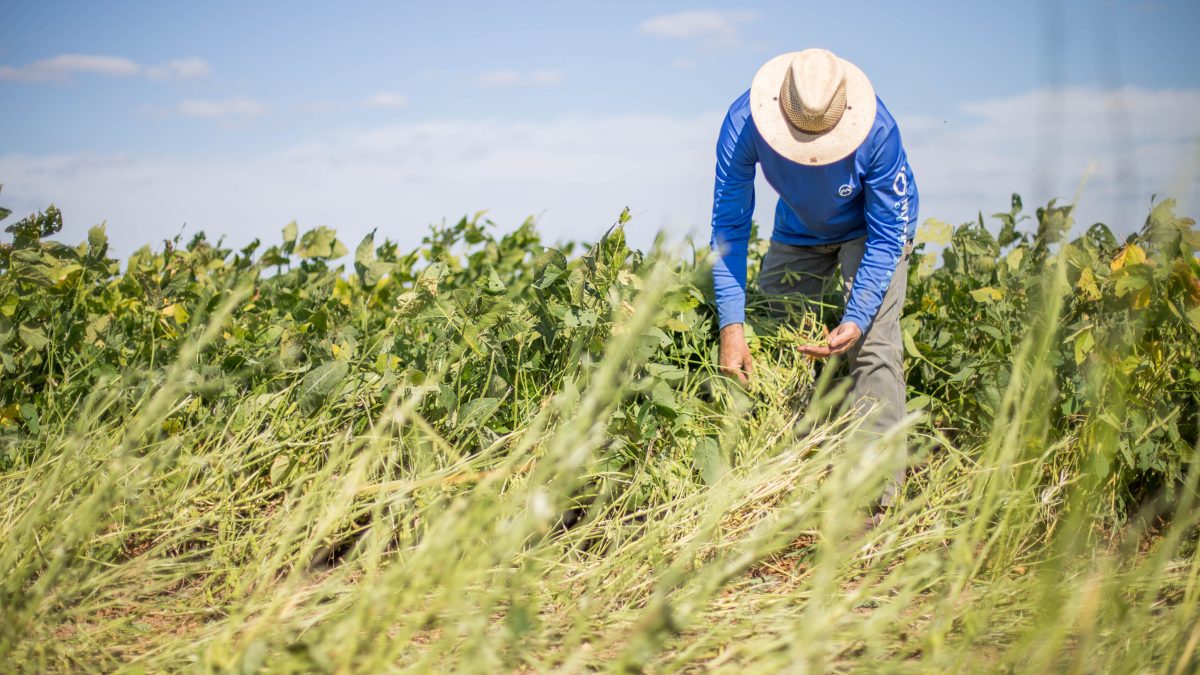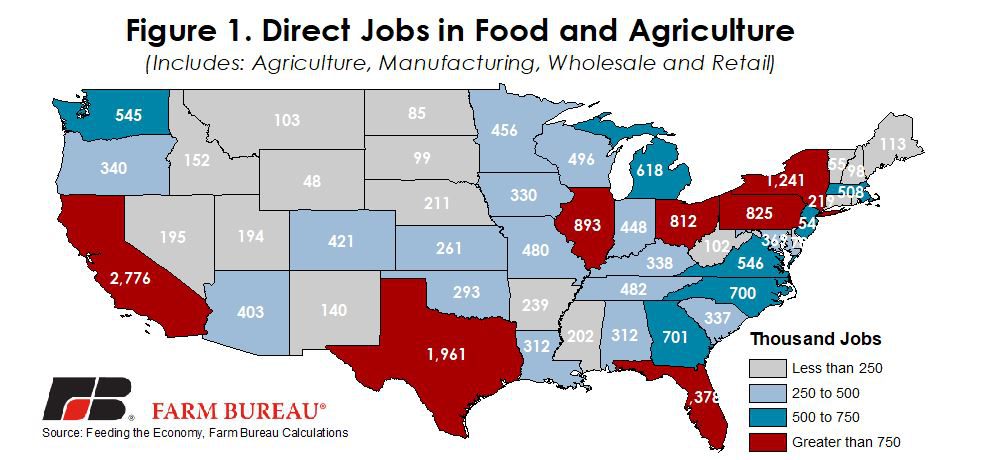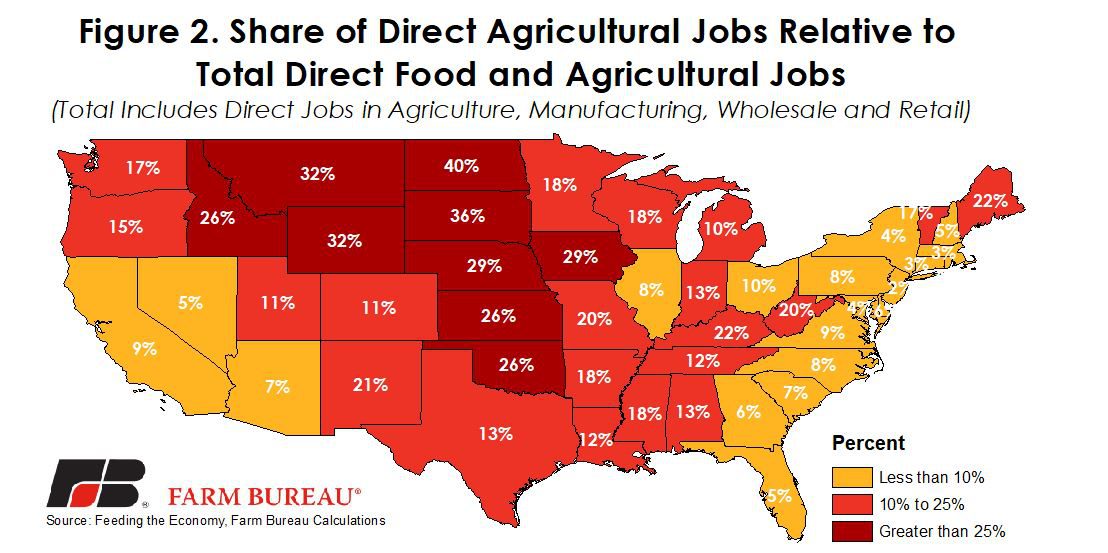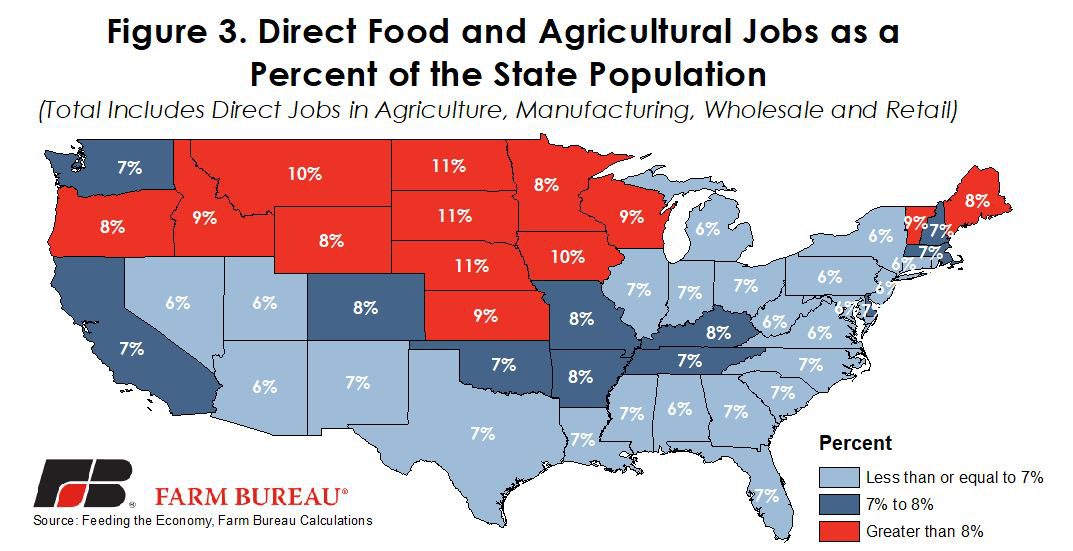Feeding the Economy: Agricultural Jobs by State
TOPICS
Labor
photo credit: Maddison Stewart, Arkansas Farm Bureau; used with permission.
John Newton, Ph.D.
Vice President of Public Policy and Economic Analysis
A recent Feeding The Economy study, sponsored by the American Farm Bureau Federation and other organizations, was designed to measure the direct and indirect impact of U.S. food and agricultural industries on various economic factors, including employment, wages, economic output, tax revenue and exports. Today’s article, the first in a series delving into the study, reviews agriculture’s direct impact on the U.S. economy and provides a state-level overview of direct agricultural jobs.
The Feeding the Economy study revealed U.S. jobs directly related to food and agriculture, including direct farming and ranching, manufacturing and wholesale and retail functions, total 22.8 million jobs, representing approximately 15 percent of all U.S. employment based on February 2019 Bureau of Labor Statistics employment data. These direct jobs represent total wages of $729 billion and generate an economic output of $2.1 trillion dollars.
This study was conducted using input-output economic modeling utilizing IMPLAN software. The underlying data of the model used in this study is based on 2016 employment and output data, which is used in conjunction with industry growth rates to estimate 2019 levels.
Food and Agricultural Jobs by State
Direct food- and agriculture-related jobs include a variety of functions such as commodity production and farming activities, manufacturing and wholesale and retail channels. Importantly, industries included in this study go beyond purely agricultural jobs and include many jobs further down the supply chain, such as food manufacturing and service.
The largest direct job category in food and agriculture is retail, e.g., grocery and food service, which represents 17 million jobs, or 75 percent of all direct agricultural and food jobs. Principal farming jobs total 2.6 million and represent 11 percent of all direct food and agricultural jobs. Following direct farming activities are manufacturing jobs, e.g., rice milling or tortilla manufacturing, at 2.1 million jobs, or 9 percent, and then wholesale jobs at 942,000 jobs, or 4 percent of all direct food and agricultural jobs.
The number of direct food and agricultural jobs is the highest in states with agricultural- and labor-intensive industries, as well as large population centers that support the retail food sectors. California leads the nation with 2.8 million direct food and agriculture jobs, followed by Texas at 2 million jobs and Florida at 1.4 million jobs. Figure 1 highlights direct agricultural jobs by state.

Agricultural Job Intensity
At the national level, approximately 11 percent of food and agricultural jobs are in farming-related activities, while 89 percent of food and agricultural jobs are downstream in the supply chain. To measure the agricultural job intensity across the U.S. the percentage of direct agricultural jobs to total direct jobs in food and agriculture, i.e., agricultural jobs divided by the sum of direct food and agricultural jobs across the agricultural, manufacturing, wholesale and retail supply chain, was calculated. This intensity level will identify which states have a higher percentage of food and agricultural jobs directly tied to farming.
At the state level, the agricultural job intensity ranges from less than 2 percent to as high as 40 percent. The intensity of direct agriculture-related jobs is the highest in North Dakota and South Dakota, where 40 percent and 36 percent of all food- and agriculture-related jobs are directly tied to agriculture, respectively. In many states, primarily in the West and Midwest, the percent of direct food- and agricultural-related jobs is greater than 25 percent.
In portions of the country with higher metropolitan populations and less agricultural production, the percentage of jobs directly tied to agriculture is lower. For example, in Massachusetts, Connecticut and New Jersey, less than 3.5 percent of food and agricultural jobs are directly tied to farming activities. Figure 2 highlights the share of agricultural jobs relative to all direct food and agriculture jobs.

Another measure of employment intensity in agriculture is direct agricultural jobs as a percent of the state population. The percent of the population directly employed in food or agriculture was 6.9 percent at the national level but ranged from a low of 5.6 percent in West Virginia to a high of 11.3 percent in South Dakota. As expected, the percent of the population directly employed in food and agriculture was the highest in portions of rural America with high concentrations of food and agricultural activities and a lower population. Figure 3 highlights the percent of the population directly employed in food and agriculture.

Summary
A recent Feeding the Economy study, co-sponsored by the American Farm Bureau Federation and conducted using IMPLAN economic impact analysis software, revealed total direct jobs related to food and agriculture at 22.8 million. These food and agricultural jobs represent total wages of $729 billion, federal tax contributions of $537 billion, state tax contributions of $376 billion and generate economic output of $2.1 trillion -- proving that agriculture and its related industries have a sizable impact on the U.S. economy.
Top Issues
VIEW ALL